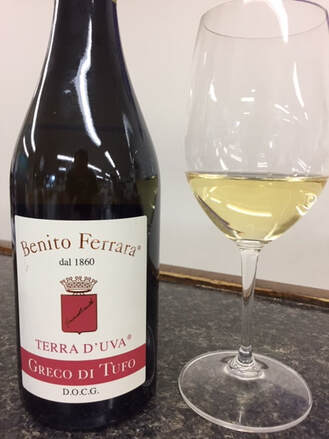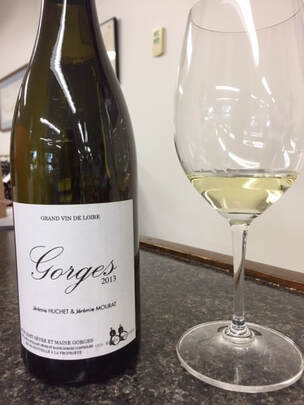 The vast, vast VAST majority of the time (did we mention vast?), Pinot Noir in Burgundy is a stand-alone variety, with the best wines of the region being 100% Pinot 100% of the time. There are a few wines that do involve blending another grape in, which is based on tradition from history. The comedians out there will say sneaking in tanker loads of Syrah from the Rhone and other points South to fatten up weak wines is a 'tradition' as well (a long standing trope from the loosely controlled days of winemaking the the 1900s). But many people forget that the Beaujolais region is included in Burgundy, and there was a time when the Gamay grape had much more overlap in where it was planted with Pinot Noir. In particular the Macon and the Cote Chalonnaise areas still find a handful of producers that have both varieties planted, and from them the delightful Bourgogne Passetoutgrain is made. Even with only 10%-15% of Gamay in the blend, it can take some of the austere edge off of the Pinot that the Chalonnaise wines tend to show, and makes for delicious drinking even in the warmer days of Summer. While most producers tend to use younger vines in their Passetoutgrain, great ones like Dureuil-Janthihal have Pinot vines of over 50 years, and the maturity is immediately noticeable in the deep Burgundian dark cherry and savory red fruit aromas, with the Gamay throwing in a touch of warm red fruits. The Gamay is much more evident on the palate, providing super fine tannins that almost disappear entirely behind the mouthwatering red fruits and tart cranberry flavors. While there is no need to age the wine for any length of time to soften out the tannin, the freshness of the acidity give everything about the wine so much vitality that it would certainly survive and thrive for several more years in case you forget a bottle or two by accident. Which could happen, because fans will want to buy this by the fistfull.
0 Comments
 Italy is a treasure trove of unique local grape varieties, with well over 100 red AND white grapes used in their appellation system. The majority of them are regional specialties that have an identity in the area they are grown, but have little international recognition otherwise and rarely get planted or emulated elsewhere. In some ways the lack of recognition is sad because of the great diversity and untapped potential quality (the world does NOT need another 10,000 acres of Chardonnay at this point), but it also makes Italy that much more special and unique, and there is still so much there to explore. Campania and the area around Naples is a particular hotbed, with immense diversity of climates and soils along the volcanic mountain ranges that provide numerous wine making possibilities. Greco is one of the area's noble white grapes (along with Falanghina and Fiano), which reaches its best expression in the high altitude vineyards of the Tufo D.O.C. The presence of sulfurous rocks (the 'tufo' in their name) gives the wines a distinctive minerality that cuts through the richness of the grape and provides some zest to the natural perfume. As much as we in Charlottesville would like to think the bottling name translates to 'Land of Wahoos', the nickname 'Land of Grapes' is an apt description of the region. Pale gold in the glass, the first aromas are immediately rich and perfumed, almost flowery like a Viognier but with more white fruits and cooler citrus tones. As it opens up the zestier Mediterranean fruits and more mineral elements start to emerge, so it never gets into the tropical or sweeter flavors. The palate has a rich natural unctuous texture hat comes from a light natural pressing of the grapes (not oak aging or residual sugar), and the fine prickly minerality give the white fruits a quenching lingering mouthfeel. The finish has a bit of stone fruit/melon rind type dryness and firmness that lends a drier sense to the finish than just wet fruits, which gives it a LOT of food potential as every good Italian white wine should. An incredibly lively wine that's great with richer seafood dishes, especially those that feature a lot of citrus, as well as even pork.  We always love to break down stereotypes in the wine world to educate customers about the almost infinite possibilities wines have to offer. Rieslings aren't ALWAYS sweet, and neither are Roses. Chardonnay isn't ALWAYS oaky. Pinot Grigio isn't the ONLY white wine that comes from Italy. And so on. The stereotype for wines from the Muscadet region of France is that they can only be super straightforward, lightweight and the Melon de Bourgogne grape is only worth making in the most simplistic of methods. Perfect to match with fresh oysters or other bivalves, but barely worth making a fuss. NOT SO FAST! Recent years has seen an increase in producers seeking out parcels of older vines to make more singular and distinctive around the city of Nantes, and have even begun identifying some of the more unique soil types to develop Cru levels for the more important vineyards. Many producers are using these vineyards to patiently age the wine in more modern fermentation and concrete storage vessels that can protect the juice from oxidizing without adding an outside flavor like oak barrels would. This wine is a prime example of what Muscadet has become, featuring the double shot combination of the enriching effects from distinctive blue clay prevalent in the Gorges sub-region of Sevre et Maine and five years of rest on its lees in concrete tanks before bottling. No one should be taking wines like this lightly. A pale gold in the glass belies the intensity of the nose, loaded with lemon peel and salty citrus, as well as touches of brininess throughout, as if a couple drops of oyster liquor were dripped into each glass.The palate is both full and wet at the same time, clean and quenching without feeling thick or lingering but still having significant substance. Lots of zesty citrus rind gives texture to the salty lime and pear skin fruit, and the extra lees time greatly extends the mouth-watering sensation on the finish, especially as the wine opens up over a few hours. This is everything an everyday Muscadet is but with the volume turned up and the knob ripped off, built to provide a little extra decadence that few would have expected from this region a decade or so ago.  Experimentation in the wine world usually happens using small steps and small amounts of wines. You can't make bold changes with the bulk of your production for fear of the financial disaster should something go wrong. This is why most of the more avant-garde trends in winemaking evolve from regions that have excess volume (France, Spain, Italy) and can spare the odd 500 case production without batting an eyelash, or from forgotten vineyards of less desired grapes (Chile, Argentina, California) that nobody was using anyway. Virginia has neither of these situations, with most wineries struggling to find enough mature and quality vineyards to get them from one vintage to the next. Most experiments happen in 1-2 barrel lots (R Wines, Lightwell Survey) if at all. Which is why Early Mountain's 'Young Wine' series is such a breath of fresh air, building both the white and red offering in a 'bistro' style using more naturalist styles of wine making. It would be very easy to make a Vidal Blanc in the slightly sweet mode that most wineries put forward, but this provides a whole new direction for a grape that actually does quite well in our climate. A bright gold color in the glass, but if you look closely at the wine in the bottle there is the slightest of haze to the wine from being left unfiltered and only the slightest of clarification. This is one of the more natural/non-intervention styles of winemaking employed here that helps give the wine more texture without having to leave in residual sugar or age it in barrels. The melon and pear fruit aromas get a pop of cool citrus that freshens them up considerably, almost hinting at the zestiness of a Sauvignon Blanc. On the palate the texture is clean and quenching with the fruit leaning into the drier more melon rind profile as well as a pear skin and slightly herbal finish. This is not your typical safe and simple Virginia wine, but a successful version of a bistro style wine that you will be hard pressed to find done as well on domestic soil. Pop and enjoy with all kinds of light cheeses, snacks, and small plate dishes. |
The Best of the Best.We offering free tastings on these wines in the store every Thursday and Friday, and a 10% discount off the retail price through the duration of the day. Come on by and give them a try! Archives
July 2024
Categories |
Location |
|

 RSS Feed
RSS Feed